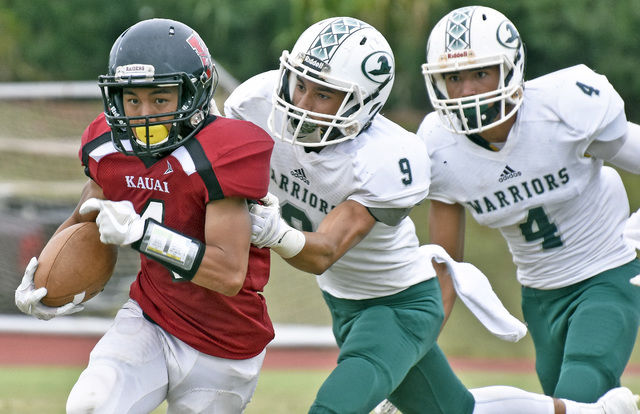The governing body of high school athletics has made changes aiming to further make football safer. The National Federation of State High School Associations (NFHS) in a release on its website announced rule changes that will be in place for
The governing body of high school athletics has made changes aiming to further make football safer.
The National Federation of State High School Associations (NFHS) in a release on its website announced rule changes that will be in place for the 2017 season.
The NFHS oversees most high school sports in the United States, including the Hawaii High School Athletic Association, which also includes the Kauai Interscholastic Federation.
“I think they’re always trying to make the game safer. But in the game of football, it is a violent sport,” said Waimea High School varsity football head coach Jason Caldeira on Wednesday. “It’s hard to keep them safe because the whole purpose of the game is to hit the other guy as hard as you can, you know? But I can understand they’re always trying to find ways to make the game safer. But it’s a difficult task because the game of football, it can be a violent sport.”
Of the new changes, three are perhaps the most significant:
New definition of a blindside block
The new definition established by the NFHS Football Rules Committee is “a block against an opponent other than the runner, who does not see the blocker approaching,” is now assessed a 15-yard penalty.
The committee, according to the release, further defines that a blindside block “involves contact by a blocker against an opponent who, because of physical positioning and focus of concentration, is vulnerable to injury. Unless initiated with open hands, it is a foul for excessive and unnecessary contact when the block is forceful and outside of the free-blocking zone.”
Essentially, unless the defender sees the blocker coming and is aware of an oncoming hit, the blocker must initiate contact with open hands outward.
Elimination of the pop-up kick
A pop-up kick is now defined as “a free kick in which the kicker drives the ball immediately to the ground, the ball strikes the ground once and goes into the air in the manner of a ball kicked directly off the tee.”
The removal of the pop-up kick basically eliminates the onside kick, in which the kicking team kicks the ball short hoping to regain possession before the receiving team can control the ball.
Such kicks will be penalized as a dead-ball, free-kick infraction, according to the release, and that the change was put in place “in an effort to reduce risk of injury because of the increased use of the pop-up kick on onside kickoffs.”
Expansion of examples of a defenseless player
The NFHS Football Rules Committee added specific examples of a defenseless player. The release stated those examples include but are not limited to:
w A player in the act of or just after throwing a pass;
w A receiver attempting to catch a pass who has not had time to clearly become a runner;
w The intended receiver of a pass in the action during and immediately following an interception or potential interception;
w A runner already in the grasp of a tackler and whose forward progress has been stopped;
w A kickoff or punt returner attempting to catch or recover a kick, or one who has completed a catch or recovery and has not had time to protect himself or has not clearly become a ball carrier;
w A player on the ground including a ball carrier who has obviously given himself up and is sliding feet-first;
w A player obviously out of the play or not in the immediate vicinity of the runner;
w A player who received a blindside block with forceful contact not initiated with open hands.
Kapaa High varsity football head coach Philip Rapozo said while some of the changes are warranted, there are others he feels are a bit much.
“The one that bothers me is when the quarterback is in a throwing motion and you cannot touch him,” he said. “How do you pull up on that, you know what I mean? That’s the one that’s kind of sketchy, but it’s a rule. We have to get used to it. We’re going to have to abide by it and figure it out.”
Another change includes the expansion of the situations required for encroachment to occur. The rule before stated that it occurs when “any other player breaks the plane of the neutral zone.”
The encroachment rules now include that defensive players are restricted from contacting the ball prior to the end of the snap or making contact with the snapper’s hand(s) or arm(s) until the snapper has released the ball.
“My initial response to that was, if it’s anything to do with making the game safer and protecting the kids, I’m for it,” said Kauai High varsity football head coach Derek Borrero on Friday.
“Sometimes, changes and different rules can be challenging. But you know, you need to take a good look at it first and break it down.
“I don’t believe that these officials, or whoever sits in the boardroom and decides on these changes, are thinking about, ‘What are the best possible ways we can make this game tougher?’ They’re always looking out for what’s best for the kids,” he continued.
“We just got to deal with it and do our best to abide by it.”
Other approved changes stated in the release regard ball specifications, uniforms, game officials, post-scrimmage kick fouls, penalty time clock management, prosthetic limbs and forward pass interference, in which the previous foul for non-contact face guarding was eliminated as forward-pass interference.


